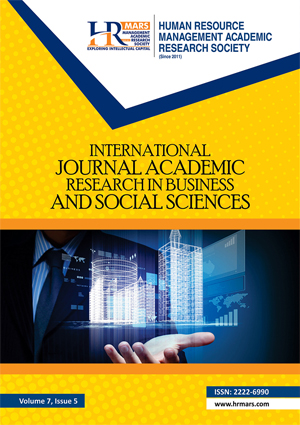
ISSN: 2222-6990
Open access
Tengku Mariam's reputation as a palace poetess may not be widely recognized and has often been overlooked by scholars, despite her extensive contributions spanning various genres. Most existing research on Tengku Mariam has concentrated on her involvement in the performing arts, particularly her influence on the Pahang joget gamelan (a traditional Malay dance) in Terengganu. Therefore, there is an urgent need for a study that sheds light on Tengku Mariam's literary accomplishments and contributions, thereby bringing greater awareness to the content of the Malay manuscripts she produced as a palace poetess. This study, titled Exploring the Literary Works of Tengku Mariam: Analysis of Manuscripts and Contributions to Culture, History, and Politics, utilizes library methods and text analysis to fulfil its objectives. The primary goals include identifying and presenting the themes present in Tengku Ampuan Mariam's manuscript writings and analysing these themes within the collection housed by the Terengganu State Museum. The results reveal that Tengku Mariam's manuscripts encompass themes such as culture, history, and politics. This research aims to provide a comprehensive understanding of Tengku Mariam's literary works and serve as a valuable resource for individuals seeking insight into the substance of her manuscript writings.
Abd. Azam, A., & Yatim, O. (2012). Manuskrip Lama: Asas Keupayaan dan Kearifan Melayu Tradisi. International Journal of the Malay World and Civilization(IMAN), 30 (1) : 29-39
Abdullah, M.Y. (2001). Naskhah-Naskhah Kesultanan Melayu di Muzium Negeri Terengganu. Kertas Kerja Bengkel Kajian Naskhah Kesultanan Melayu, 2-5 Julai 2001, Hotel Quality, Kuala Lumpur.
Ahmad al-Jafari, S.M.A. (2023). Pelestarian Warisan Kebudayaan Melayu Menyumbang Kepada Penjagaan Agama. Journal of Fatwa Management and Research, 28(3):113-128.
Chepa, N., & Wan Yahaya, W. A. J (2017). Reality And Challenges Of Malaysian Digital Traditional Games. Journal of Engineering Science and Technology Special Issue on ISSC’2016, 209 – 218.
D’Cruz, M. (2020). The Royal Dance of the Pahang and Terengganu Courts. In Sharing Identities: Celebrating Dance in Malaysia, ed. Nor, Mohd Anis and Burridge,S,. 1-23. London: Routledge India.
Denisova, T. A. 2011. Refleksi Historiografi Alam Melayu, Kuala Lumpur: Universiti Malaya.
Harun, J. (2001). Manuskrip Negeri Pahang : Membicarakan Tokoh Pengarang & Penyalin. Seminar Persuratan Pahang: Menjejak Warisan Pahang, 27-28 Oktober at Auditorium Taman Budaya, Kuantan, Pahang.
Harun, J. (2015). Syair Tawarikh Zainal Abidin Yang Ketiga Sebuah Karya Agung Terengganu. International Journal of the Malay World and Civilisation, 3(2) : 3 – 15.
Ibrahim, A. O. (2005). Joget Gamelan Terengganu & Pahang: Penerus Tradisi Seni Persembahan Istana Kesultanan Melayu Melaka (Z. Jazlan, Ed.). Kuala Lumpur: Kementerian Kebudayaan, Kesenian dan Warisan Malaysia.
Lacksana, I. (2017). Kearifan Lokal Permainan Congklak sebagai Penguatan Karakter Peserta Didik melalui Layanan Bimbingan Konseling di Sekolah. Satya Widya, Vol. 33 (2): 109-116.
Lickona, T. (2012). Educating for character (U.Wahyuddin, ed.; J. A. R. Zien, Trans.). Bumi Aksara.
Maizan, S. H. (2018). Congkak Variations through Design Transformation. Ideology Journal 3 (3): 114-126.
Mat Piah, H., & Ismail, S. Z. (1986). Pejabat Setiausaha Kerajaan Negeri Terengganu dan Universiti Kebangsaan Malaysia.
Mohamad Amran, N., Wan Zin, W. N. A, Abdul Kadir, I. K, & Mohd Yunus, A. (2018). Joget Melayu Istana Tarian Gamelan Menerusi Kaedah Sejarah Lisan. Jurnal Sejarah Lisan Malaysia, 2(2):78-89.
Mohamad, N.Z. (2012). Joget Gamelan Terengganu Dari Aspek Penceritaan Dan Cabaran Pemeliharaannya (Doctoral dissertation, Universiti Malaysia Sarawak). https://ir.unimas.my/20248/1/Joget%20Gamelan%20Terengganu%20dari%20aspek%20penceritaan...%2824%20pages%29.pd.
Mohamad, Z. (2022). Joget Gamelan: Di Manakah Keberadaannya?. Dalam Mohd Hanafiah, H. A Abdullah, M. A. R, Jusoh, Z. Kamaruddin, R & Atan, E. Prosiding Seminar Antarabangsa Linguistik dan Pembudayaan Bahasa Melayu ke-11. Serdang: Universiti Putra Malaysia Press.
Mohd Tohar, S. N. A, & Abdul Latiff, L. (2017). Semangat kekitaan melalui Teori ‘Asabiyah Ibnu KhALDUN: Aplikasi dalam Masyarakat Multi Etnik Malaysia. Proceding of International Conference of Empowering Islamic Civilization Research Institute for Islamic Product and Malay Civilization (INSPIRE). Universiti Sultan Zainal Abidin. 7-8 Oktober.
Mohd Yusri, A. F, & Yang, A. J. (2024). Pemupukan Semangat Patriotisme Melalui Permainan Tradisional Dalam Mata Pelajaran Sejarah: Satu Tinjauan Umum. Jurnal Wacana Sarjana, 8(2): 1-9.
Mukmin, M. J. (2011). Sejarah Hubungan Diplomasi Kerajaan Melayu: Satu Tinjauan. Jurnal IKSEP, 2: 71-90.
Norsafini, J., & Premalatha, T. (2023). Performing Joget Gamelan through archives and social memory. Cogent Arts & Humanities 10:1-15.
Rusmana, Dheka, D., A. (2010). Permainan Congkak: Nilai dan Potensinya bagi Perkembangan Kognitif Anak. Patanjala, 2 (3): 537 – 549.
Taib Saearani, M. T and Agus Cahyono, A. (2016). The Inheritance of Malay Palace Dance in Malaysia and Yogyakarta Classical Dance in Indonesia. HARMONIA : Journal of Arts Research and Education, 16 (1): 75-86.
Muhammad, S. J. N. (2025). Exploring the Literary Works of Tengku Mariam: Analysis of Manuscripts and Contributions to Culture, History, and Politics. International Journal of Academic Research in Business and Social Sciences, 15(2), 1077–1091.
Copyright: © 2025 The Author(s)
Published by HRMARS (www.hrmars.com)
This article is published under the Creative Commons Attribution (CC BY 4.0) license. Anyone may reproduce, distribute, translate and create derivative works of this article (for both commercial and non-commercial purposes), subject to full attribution to the original publication and authors. The full terms of this license may be seen at: http://creativecommons.org/licences/by/4.0/legalcode